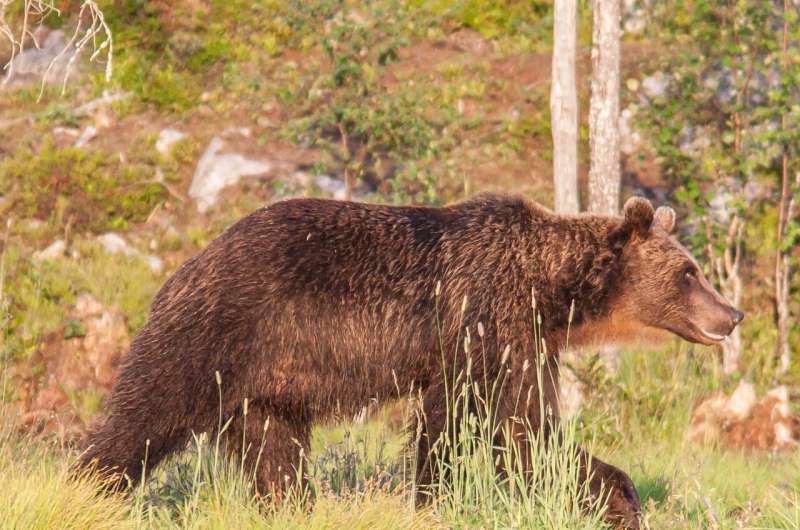Brown bear in eastern Finland. Interestingly, the effects of protected areas on bear densities varied depending on the methodology used. Credit: Daniel Burgas-Riera
A recent study, led by the University of Helsinki, used a novel combination of statistical methods and an exceptional data set collected by hunters to assess the role of protected areas for carnivore conservation in Finland.
Overall, protected areas do not harbor higher densities of large carnivore species than unprotected lands. These areas even had declining wolverine densities within their limits while populations outside remained overall stable over a 30-year study period. The study was published in the journal Nature Communications.
The international group of authors, led by Dr. Julien Terraube from the Faculty of Biological and Environmental Sciences at the University of Helsinki, proposes that the results do not indicate that protected areas are unimportant for carnivore conservation, as they may support seasonal habitats and prey for these highly mobile species. However, the outcomes highlight complex socio-ecological pressures on carnivore populations that vary in both time and space and affect the conservation outcomes of protected areas. For example, the largest Finnish protected areas are located in Lapland, and due to their sizes these areas are most suitable for large carnivores. However, the areas seem unable to maintain stable wolverine populations, which may be linked to increased conflicts with herders in the reindeer husbandry area.
"Wolverines are only found in three Nordic countries within the European Union, and therefore Finland plays an important role for the conservation of this species," explains Dr. Terraube. He adds: "The negative trend of wolverine populations inside northern protected areas is alarming and highlights that further research is needed to understand the dynamics of wolverine populations in Lapland, how this species is affected by illegal killing and what protected areas could do to improve this situation."
On a brighter note, the researchers also found lynx densities to be higher within protected areas located in eastern Finland than those located in the western part of the country. The ecological factors that may influence this, such as prey abundance or connectivity to healthy Russian populations, remain unexplored.
The potential of citizen science for assessing the impact of protected areas
The results show that counterfactual approaches applied to long-term and large-scale data are powerful analytical tools for evaluating the effectiveness of protected areas in maintaining wildlife populations. A counterfactual approach means comparing protected and unprotected sites that have similar environmental characteristics or human-caused threats. The method has been increasingly used to assess the effectiveness of protected areas in halting deforestation. This allows researchers to isolate the effect of protection on land cover from other confounding factors such as elevation. Until now, these types of approaches focused on matching analyses have been restricted to studies investigating the effects of protected areas on land-use changes. Finding wildlife time series with enough temporal and spatial coverage to conduct such robust effectiveness assessments is often difficult.
Dr. Terraube explains: "We were able to use data collected through the Finnish Wildlife Scheme to conduct this study. Hunters throughout the country have collected this data set since 1989, offering a fantastic opportunity to apply matching analyses to wildlife data for the first time and to assess large-scale and long-term patterns of protected area effectiveness. We chose to focus on large carnivores, as this species group is particularly prone to rising conflicts with local communities. Carnivore-human conflicts have increased in Finland following the recent recovery of most carnivore species. This has resulted in increasingly negative attitudes toward certain species, such as the wolf, and to increased levels of illegal killing."
Mainstreaming impact evaluation: toward better management of protected areas
The study highlights the need to design robust methodological tools to strengthen our understanding of conservation outcomes and opens new avenues for improving protected area impact assessments. This is of the utmost importance, as the international community is currently turning to the post-2020 targets drafted by the UN Convention on Biological Diversity aiming to upgrade protected areas in an attempt to halt global biodiversity loss.
"We argue that this study shows that, despite methodological challenges, robust assessments of protected area effectiveness for the conservation of wide-ranging species, such as large carnivores, are possible and greatly needed as a basis for further research. It also highlights the extraordinary value of long-term wildlife monitoring activities conducted by citizens across an entire country," concludes Dr. Terraube.
More information: J. Terraube et al. Assessing the effectiveness of a national protected area network for carnivore conservation, Nature Communications (2020). DOI: 10.1038/s41467-020-16792-7
Journal information: Nature Communications
Provided by University of Helsinki























